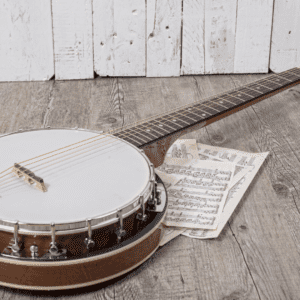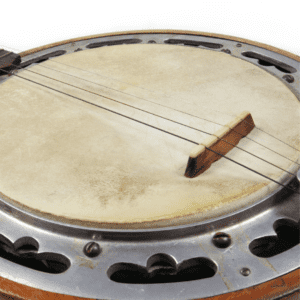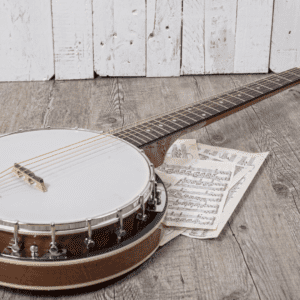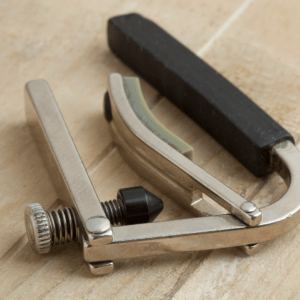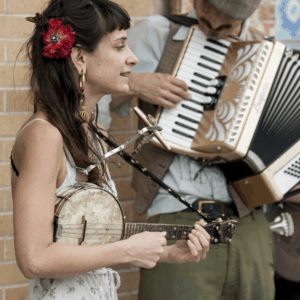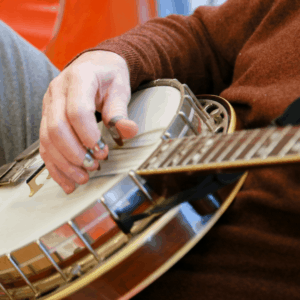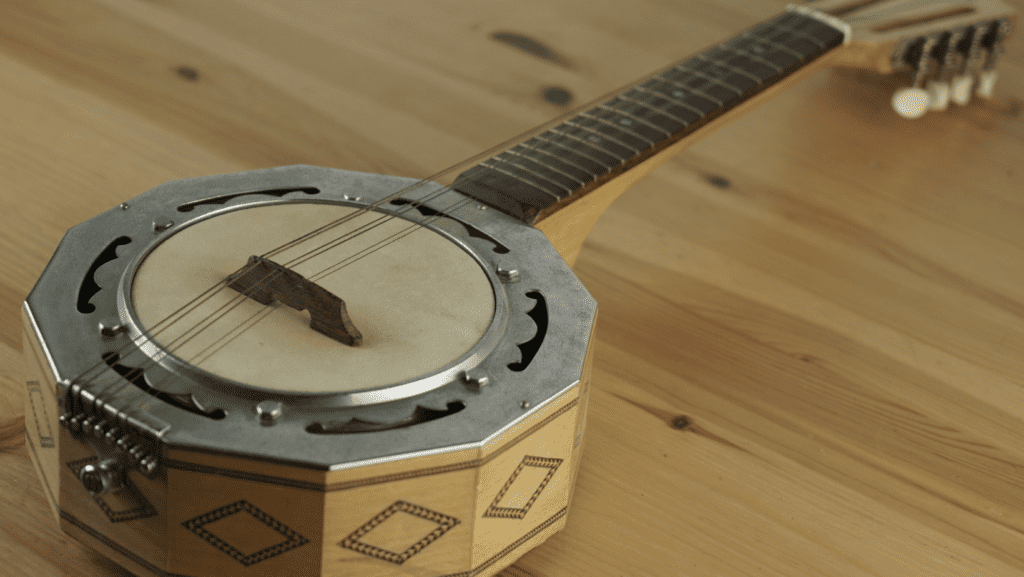
Whatever your reasons for thinking about starting to learn the banjo, choosing an instrument can be daunting for the beginner and uninitiated. The banjo has soared in popularity in recent years and has moved beyond country and folk music and into more of the mainstream. This has made it appealing to all kinds of musicians. Whether you’re new to music altogether or already have experience and are looking to learn another instrument, read on for tips about choosing the best beginner banjo for your needs.
| 1.Best Beginner Banjo Editor’s Choice – Deering Goodtime 5-String Openback Banjo A durable and lightweight banjo made by Deering. Features a maple and ebony construction. | Buy on Amazon | |
| | 2.Best Beginner Open Back Banjo – Deering Goodtime Americana Banjo 12 In. Rim A beautifully made banjo with an engraved scroll head and warm and clear tone in the bass register. | Buy on Amazon |
| | 3. Best Beginner 5-String Banjo – Gold Tone, 5-String Banjo (CC-100RW) Made by a reputable manufacturer with a maple tone ring, neck, and resonator and a two-way adjustable truss-rod. | Buy on Amazon |
| | 4.Best Beginner 4 String Banjo – Kmise Tenor Banjo Features a removable resonator, sapele back and sides, and everything a beginner needs to start learning. | Buy on Amazon |
| | 5. Best Banjo Ukulele For Beginner – Aklot Banjo Ukulele A banjolele with a maple fretboard and a two-way adjustable truss-rod. | Buy on Amazon |
| | 6. Best Beginner Banjo Tuner – D’Addario Micro Banjo Tuner One of the few tuners built specifically for the banjo, it seamlessly blends into the aesthetics of the instrument. | Buy on Amazon |
| 7. Best Beginner Banjo Book – Absolute Beginners – Banjo: The Complete Picture Guide to Playing the Banjo Includes all the techniques and nomenclature a beginner should familiarize themselves with. Includes step-by-step pictures and audio. | Buy on Amazon |
7 Best Beginner Banjos reviewed
Best Beginner Banjo Editor’s Choice: Deering Goodtime 5-String Openback Banjo
The Deering Goodtime 5-string Openback Banjo is a well-made, durable, and user-friendly instrument. It comes with a padded bag and tuner and produces a ringing tone thanks to the violin-grade maple rim. It’s lightweight, weighing around 4 pounds, making it perfect for beginners, and children alike to play for extended periods and avoid fatigue. It’s also easy to travel with so you can take it with you anywhere and play when inspiration strikes.
The bridge is made from maple/ebony and the gear head is fiddle style.
Pros
- Durable and well-made by a reputable manufacturer.
- Maple rim and maple/ebony bridge.
- Lightweight.
- Includes travel bag and tuner.
Cons
- The finish isn’t the most attractive or eye-catching.
Best Beginner Open Back Banjo: Deering Goodtime Americana Banjo 12 In. Rim
The Deering Goodtime American offers a fantastic tone with superb bass response and a warm tone. The simple and classic aesthetic of the finish is complemented by the renaissance engraved head. The rim is made from violin-grade maple, the neck is a beautiful slim maple and the bridge is maple/ebony to ensure a smooth sound.
All in all a high-quality instrument suited to beginner players and beyond and will likely last further than your initial beginner stage, potentially even a lifetime. If you can afford the higher price on this or the previous model, you won’t regret it as the quality speaks for itself.
Pros
- Made from high-quality materials.
- Beautifully engraved scroll head.
- A warm tone with an emphasized bass tone
Cons
- Reportedly lacks tonal clarity on the higher frets
Best Beginner 5 String Banjo: Gold Tone, 5-String Banjo (CC-100RW)
The Goldtone 5-string banjo is a good option for beginners who want something that’ll last a little beyond their fledgling stage. It features a maple neck, tone ring, and resonator. The brass truss rod and two-way tailpiece ensures that you can adjust the instrument to suit your playing style and keep your instrument functioning well if you’re moving around areas with different climates.
GoldTone is a respected name in the banjo world, so you can rest assured that you’ll get a good tone and decent playability. Whilst the price is higher than some other beginner models, as always (or usually) you get what you pay for.
Pros
- Made by a well-respected manufacturer in the banjo world.
- Maple neck, tone ring, and resonator.
- Brass truss rod and two-way adjustable tailpiece.
Cons
- The string spacing is quite wide.
Best Beginner 4 String Banjo: Kmise Tenor Banjo
The Kmise Tenor 4-string banjo features a detachable backboard and produces a bright tone regardless of whether the resonator is attached or not. The drumhead is of a good standard considering the price bracket and creates a stable and reliable tone with or without the resonator.
A two-way adjustable truss rod is included which allows players to ensure that the neck stays straight in different climatic conditions. The back and sides are made of Sapele and a strap is included that can serve a variety of purposes. Also included is a piezo pickup so you can plug in and play on stage, or record with ease. Everything a beginner could need to begin learning is also included, such as strings, picks, tuner pegs, a digital tuner, and an allen wrench.
Pros
- Sapele sides and back.
- Two-way adjustable truss rod.
- Removable resonator.
- Features everything a beginner could need.
Cons
- Some users complain of quality control issues.
Best Banjo Ukulele For Beginner: Aklot Banjo Ukulele
The Aklot banjo ukulele has an open-back design with a deep rim that helps your project your sound forward to your listeners. The tone is warm and bright, reminiscent of the Appalachians. The fretboard is made from maple, and the two-way adjustable truss-rod allows you to set the action to your preference. The maple fretboard is well sanded, unlike some other cheap instruments on the market, resulting in an easy playing experience.
The drumhead is made from remo fiberskyn. Included is everything a beginner could need, alongside a two-year warranty to give you peace of mind in case anything goes wrong.
Pros
- Maple fretboard.
- Includes a two-year warranty.
- Two-way adjustable truss rod.
- An excellent beginner instrument.
Cons
- Some reviewers complain about the instrument not keeping in tune.
Best Beginner Banjo Tuner: D’Addario Micro Banjo Tuner
Whilst you can use any tuner for the banjo, the D’Addario Micro Banjo Tuner is built specifically to blend in as seamlessly as possible with the aesthetics of the banjo. The multi-colored display allows you to tune your instrument almost anywhere. The tuner works by sensing transducer vibrations so can function well even in the noisiest of environments.
Pros
- Tuner made specifically for the aesthetics of the banjo.
- Multi-colored display.
- Transducer technology means the tuner works in noisy environments.
Cons
- Some users complain the mount doesn’t stay in place.
Best Beginner Banjo Book: Absolute Beginners – Banjo: The Complete Picture Guide to Playing the Banjo
The Absolute Beginner – Banjo book gives students step-by-step pictures from day one of your banjo journey and is designed to get you playing your very first songs. It also features everything you need to know about setting up and maintaining your instrument which can be confusing and overwhelming for beginners.
Pictures are linked to audio tracks which can be slowed down, changed pitch, keys, and looped for your convenience. Written by an acclaimed banjo artist, composer, and scholar, Bill Evans, you can assure you that you are in good hands.
Pros
- Features all the techniques and nomenclature a beginner needs to familiarize themselves with.
- Includes step-by-step pictures.
- CD can be slowed down, looped, and transposed.
Cons
- Several users claim the code for the online content is absent.
Beginner Banjo Buying Guide
Why Learn The Banjo?
he banjo is a hollow fretted string instrument that’s popular in American folk music. If you want to get the classic Appalachian sound, then learning the banjo is your way to do that. Banjos have soared in popularity recently and can be found in a wide range of genres including rock, pop, and folk-rock.
The banjo is an instrument that has its roots in West Africa but developed as we know it in the USA. The banjo has become an essential part of country and folk, jazz, and rock and roll. If you want to learn any of these genres, you may be attracted to the banjo for its unique tone and character.
Whilst it seems likely that many people reading this may be attracted to the banjo because of bluegrass music, remember that the banjo has a rich history that stretches further back than the hundred years or so that bluegrass has been around. You really can play any kind of music on the banjo. Your creativity and how much time you put into learning is the only limit on your journey with the banjo, and it really can take you wherever you want it to.
What Are The Different Types Of Banjo?
Banjos can be divided into open and closed-back models. Within this category, you can have 5 strings, 4 strings, 6 strings plectrum banjos, banjolele, and various other hybrids that keep appearing.
‘Classic’ banjos are open-backed without a resonator. Banjos with resonators are favored by bluegrass players for the added sound projection they offer. The 5-string banjo has the sound that most people associate with the instrument, at least in Americana. The 5-string banjo is normally tuned to a G chord and the 5-string is shorter than the others and is attached to a tuning peg.
4 string banjos lack the 5th string that starts halfway down the neck. They can be tuned in a variety of ways, including G D A E, like a mandolin for Irish/Celtic music. They work well for different kinds of folk music. 4 string banjos aren’t the most common type of banjo but can be used for things such as chordal accompaniment, or single not melodies.
There are also 4 string banjo-ukulele hybrids known as banjoleles and are open back although some may have a resonator. They come in a variety of different scales depending on the manufacturer.
Plectrum banjos are also 4 string banjos that are typically smaller and are played with a pick (plectrum) They are typically tuned C, G, B, D, or sometimes D, G. B, E, like a baritone ukulele.
Nowadays you can even find electric banjos which are suited to recording or playing in a live setting.
Which Type Of Banjo Is Best For A Beginner?
A five-string banjo with a resonator is a good choice if you’re unsure what type is best for you. Resonators can be removed and so can the 5th string if need be, giving you more versatility than if you were to choose an open-back banjo or a 4 string.
The type of banjo you choose will often depend on what kind of music you want to play. But when you’re starting to learn the banjo, experimenting, and still trying to find your playing style, having a versatile instrument is important. This allows you to keep your options open before committing.
The best kind of banjo is steady and durable with good sound projection. You should be able to fret every note easily without pain in your fingers, and when you strum there should be no buzzing or rattling.
It’s always best to buy a quality instrument when you’re learning. Having an instrument that neither looks, feels, or sounds good makes it unlikely that you’ll stick to learning and improve. If your banjo is poorly made or set up and has bad intonation, it’s unlikely that you’ll progress, or at least it’ll likely take you much longer than if you had a quality instrument.
A quality instrument that feels and plays well will set you up with much greater chances of success than a poorly constructed instrument that hardly resembles a banjo. You want a reliable instrument, especially when you’re just beginning and may not be well acquainted with all the parts of a banjo and how they work, and how to fix things if they go wrong.
Having an unreliable instrument that requires constant attention can be a massive hindrance to learning that can easily be avoided by going for the best instrument your budget will allow.
What To Look Out For When Buying A Beginners Banjo?
When buying a beginner’s banjo, things to consider are; size, construction material, and ease of playing. Look for a durable, comfortable banjo with a strong and consistent sound.
To Sum Up
The banjo has soared in popularity in recent years and can be seen appearing across different musical genres where it previously wasn’t found. Deciding on an instrument when you’re a beginner can be daunting because you’re unlikely to know what features to look out for and which to avoid.
A beginner’s instrument is all about learning and it’s important to have an instrument that facilitates your musical explorations. An instrument is a tool that allows you to express musical ideas. Look for an instrument that allows you to do this, and avoid anything that causes frustration because of cheap materials and poor construction.
Last update on 2023-04-27 / Affiliate links / Images from Amazon Product Advertising API


